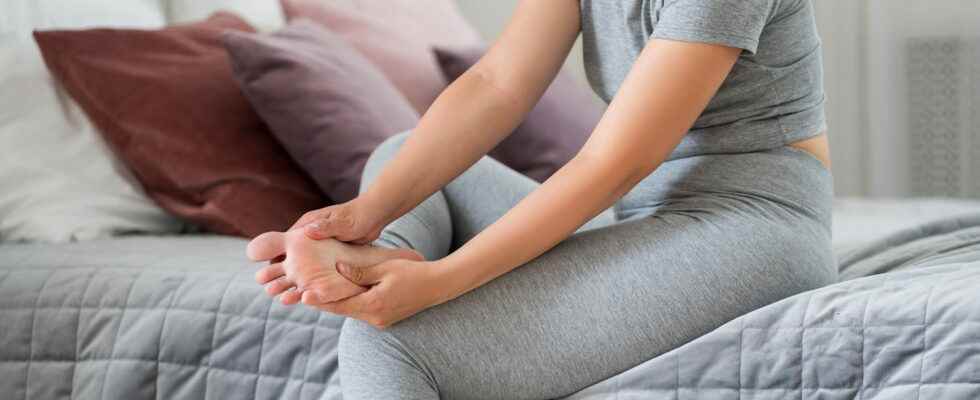Gout is a disease caused by excess uric acid in the blood causing crystals to form in and around the joints. These crystals cause very painful attacks. Pain relief advice.
The drop is a rheumatism which evolves by recurrent inflammatory attacks leading to joint deformities. Gout disease affects nearly 600,000 people in France. What are the causes a gout attack? How to prevent and relieve this affection?
What is gout disease?
Gout is a disease caused byincreased uric acid in the blood (we are talking hyperuricaemia). Uric acid is a waste product that results from the degradation of purines, normally evacuated in the urine. Above 60 mg/L, the body can no longer eliminate it and uric acid forms crystals that settle in and around the joints, causing an inflammatory reaction and very painful chronic crises. The disease affects mostly men of the the age of 30, but also women after the menopause (between 55 and 60 years old on average). Not everyone with hyperuricemia will get gout.
What are the symptoms of a gout attack?
Gout is a rheumatism that evolves by crises. It causes sudden and intense pain in one or more jointswhich occur often at night. Simply touching the sheets can become unbearable, for example. The joint appears red and swollen ; pain can be accompanied fever and chills. the big toe is the most commonly affected (in 70% of first gout attacks), but the anklethe wristthe handthe knee where the elbow may also be affected.
What causes gout disease?
Gout is caused by an increase in uric acid in the blooddue to a failure of its elimination by the kidneys. Of the family history of gout, as well as a overweight or a high blood pressure may promote the onset of the disease. Some medications can also make renal elimination of uric acid more difficult. Furthermore, the consumption of foods rich in animal protein, beer, hard liquor and sugary drinks (sodas, fruit juices) leads to increased production of uric acid.
The interrogation and the examination of the affected person generally make it possible to evoke the diagnosis of gout. The presence of risk factors : overweight, high blood pressure, family history of gout… When the patient has recurrent attacks typical of gout attacks, with hyperuricemia, it is reasonable to establish a clinical diagnosis. Apart from the clinical symptoms, a blood test and/or uric acid test content in the urine (urinary assay) generally confirms the diagnosis. In addition, the diagnosis of gout can be confirmed by presence of uric acid micro-crystals in synovial fluid or tophus (urate crystals in subcutaneous areas). Between periods of crisis, the European League Against Rheumatism (Eular) indicates that the identification of micro-crystals of uric acid at the level of asymptomatic joints can allow a diagnosis. The patient may be affected by both gout and septic arthritis. Eular recommends Gram staining and cultures, even if acid crystals are identified. The reciprocal is also valid (crystals should be sought in cases of inflammatory arthritis).
When to consult?
A red and swollen joint always requires medical consultation. Indeed, if the diagnosis of gout is not confirmed, it can also be a sign of a subcutaneous or joint infection that must be treated urgently.
What are the treatments to relieve a gout attack?
Gout is an overload disease that manifests itself in attacks. These are episodes of very acute joint inflammation due to microcrystals (deposits) observed under the skin in the ear, for example, or around the joints and tendons. Continuous treatment with uric acid lowering drugs (hypouricemic drugs: allopurinol, benemide…) at a certain level allows the melting crystals, their disappearance and therefore a disappearance of crises. Gout is ‘cured’ by maintaining these medications. treatment is continuous and must therefore be maintained for life. Stopping it triggers new crises because the crystals reform. In addition to medication, a gout attack is countered by:
- rest of the affected joint
- local app of ice
- the catch an anti-inflammatory Where of colchicine to relieve pain
- an acute attack can be treated by performing a joint puncture or via injection of corticosteroids.
- a diet containing less foods rich in animal protein (especially red meat and offal), more dairy products and vegetables, then 2 to 3 liters of water per day.
- gradual, balanced weight loss reduces gout attacks in an overweight person.
What diet reduces gout attacks?
The management of the disease of gout necessarily involves a specific diet limiting foods rich in uric acid as well as those that stimulate the production of uric acid and favoring on the other hand foods accelerating the renal elimination of uric acid (waters rich in hydrogen carbonates (Vichy, St Yorre, Badoit…), foods rich in vitamin C…).
Gout attacks, which last several days, repeating themselves at intervals of a few weeks to several years. Their frequency and duration tend to increase as the disease progresses, as does the number of affected areas. After a few years, small painless nodules (tophi) may appear under the skin. In some cases, gout can also manifest as kidney stones.
Source: What diet for gout? Cédric Ménard, Books on Demand Editions, 2017
